Old Goa is a historical site and city situated on the southern banks of the River Mandovi, within the Tiswadi taluka (Ilhas) of North Goa district, in the Indian state of Goa.

The history of Goa dates back to prehistoric times, though the present-day state of Goa was only established as recently as 1987. In spite of being India's smallest state by area, Goa's history is both long and diverse. It shares a lot of similarities with Indian history, especially with regard to colonial influences and a multi-cultural aesthetic.

Ribandar is a town in Tiswadi, Goa, located between the cities of Panjim and Old Goa.
Dom Diogo Rodrigues, Dom Diogo Roiz was a Portuguese explorer of the Indian Ocean who sailed as an ordinary helmsman under the command of Dom Pedro Mascarenhas around Goa. They sailed from the Cape of Good Hope eastward into little-known waters of the newly discovered route to Goa. Rodrigues island was named after him between 4 and 9 February 1528 because he had discovered it during his only return journey from Goa via Cochin to Lisbon, where he was elevated to the rank of a knight (cavaleiro) by John III of Portugal. He then returned to Goa and made a mark in the history of the Portuguese empire in the subcontinent around the mid-16th century.
The Konkani people are an Indo-Aryan ethnolinguistic group native to the Konkan region of the Indian subcontinent who speak various dialects of the Konkani language. Konkani is the state language of Goa and also spoken by populations in Karnataka, Maharashtra, Damaon and Kerala. Other Konkani speakers are found in Gujarat state. A large percentage of Konkani people are bilingual.

Chorão, also known as Choddnnem or Chodan, is an island along the Mandovi River near Tiswadi, Goa, India. It is the largest among other 17 islands of Goa. It is located 5 kilometres away from the state capital, the city of Panaji and 10 kilometres away from the city of Mapusa.
Cuncolim is a town in South Goa district in the state of Goa, India.
The island of Divar lies in the Mandovi river in the Indian state of Goa.

Shri Shantadurga Saunsthan is a private temple complex belonging to the Goud Saraswat Brahman Samaj located 30 km (19 mi) from Panaji at the foothill of Kavalem village in Ponda Taluka, Goa, India.
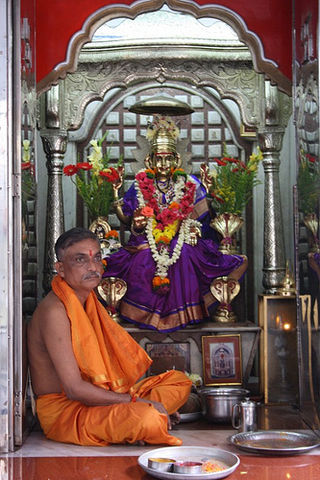
Shantadurga is the most popular form of the Hindu goddess Durga revered in Goa, India, as well some parts of Karnataka. She is a form of the ancient Mother goddess known as Santeri. She is worshipped in almost all villages of Goa as an ant hill. This is seen in some temples dedicated to Shantadurga.
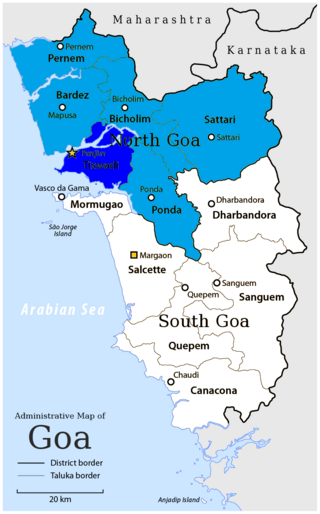
Tiswadi, formerly known as Ilhas, is a taluka in the district of North Goa, situated in the Indian coastal state of Goa. It is an estuarine island situated on the confluence of the Mandovi and Zuari rivers. It was one of the first territories to be annexed by Portugal in the sixteenth century. Both the state capital Panaji, and the erstwhile capital Old Goa lie within the subdistrict. It is the biggest and most populated of the six major islands between the Mandovi and Zuari rivers.
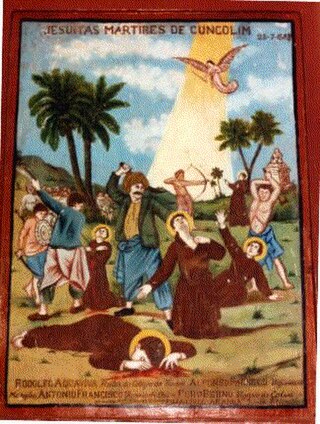
The Cuncolim Massacre or Cuncolim Revolt was an incident that involved the massacre and mutilation of Christian priests and civilians by Hindu chieftains in the Portuguese Goa village of Cuncolim on Monday, 15 July 1583.
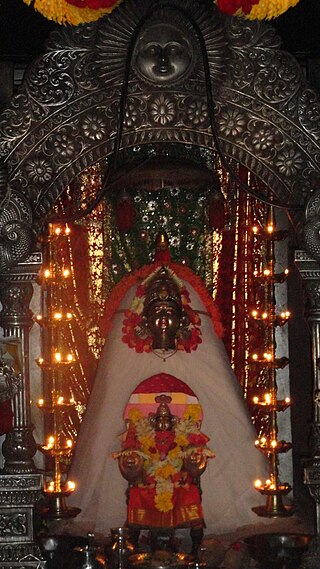
Shri Shantadurga (Kalangutkarin) Devasthan Nanora is a Hindu temple in Nanoda village, Bicholim taluka in Goa. The goddess Shantadurga is worshiped in the form of Vishweshwari.

Mangueshi is a village in Priol, Ponda, Goa, India. Mangueshi/Mangueshim are other variations for the same name.

The Portuguese conquest of Goa occurred when the governor Afonso de Albuquerque captured the city in 1510 from the Adil Shahis. Old Goa became the capital of the Portuguese India which included territories such as Fort Manuel of Cochin, Bom Bahia, Damaon & Chaul. It was not among the places Albuquerque was supposed to conquer. He did so after he was offered the support and guidance of Timoji and his troops.
St Estevam is an estuarine islet in the Tiswadi taluka, Goa state, India. St Estevam is commonly referred as Jūvã (Isle) and has earned the monicker Šākêchô Jūvõ—the island of vegetables—famed for its long, seven-ridged, light green ladyfingers. Therefore, the people of Jūvã came to be nicknamed bhennddem. The island is named after St. Stephen. It is one of Goa's most prosperous villages, often quoted by ex-Chief Minister Pratapsingh Rane for having a high per capita income.

Goa is a state on the southwestern coast of India within the Konkan region, geographically separated from the Deccan highlands by the Western Ghats. It is bound by the Indian states of Maharashtra to the north, and Karnataka to the east and south, with the Arabian Sea in the west. It is India's smallest state by area and fourth-smallest by population. Goa has the highest GDP per capita among all Indian states, two and a half times as high as the GDP per capita of the country as a whole. The Eleventh Finance Commission of India named Goa the best-placed state because of its infrastructure, and India's National Commission on Population rated it as having the best quality of life in India. It is the second-highest ranking among Indian states in the human development index.
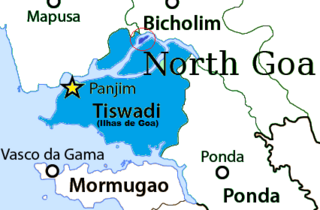
Vanxim or Capão is an island of Goa situated in the Ilhas region. One can reach here by taking a ferry from Divar. The colonial name for Vanxim was Capão. One may see a lot of houses with few villagers many of whom are fisher-folk in the area. Silveiras, Furtados, Vas, Olivera are surnames of people. Mahendra Gaunekar sold the parts of the island to Ozone corporate. Luxury hotel and Golf Course is sort to be forced upon this island but faced resistance from alert islanders and others.
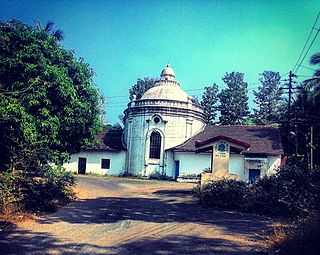
Naroa is a village located on the eastern tip of the island of Divar, in the Indian state of Goa. It has a population of barely a thousand people, with about 80 houses.
The Cumbarjua Canal is a distributary channel formed by the merger of the Mandovi and Zuari rivers in Goa, India. Its flow has led to the formation of river deltas; the most prominent of them are Ilhas de Goa, Cumbarjua and St Estevam.














